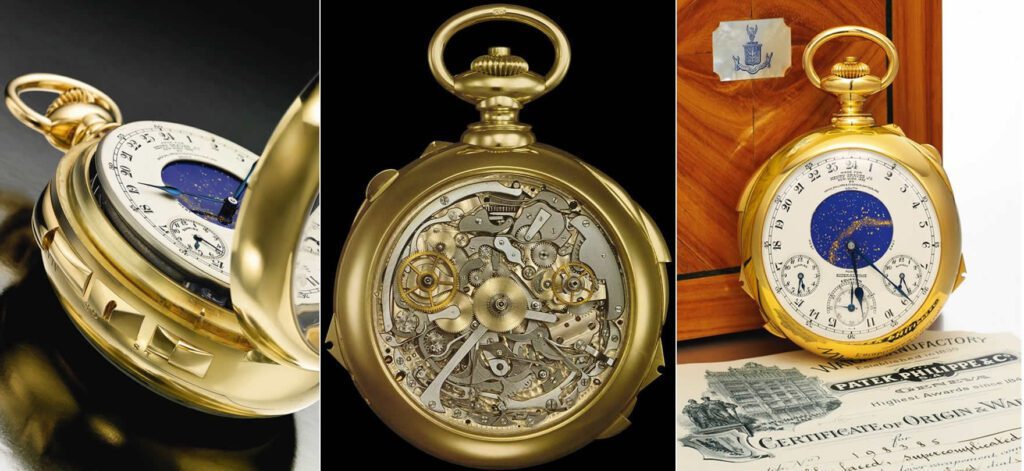Patek Philippe Supercomplication

Wristwatches are certainly the most in-vogue timepieces in our current day and age. Despite this, one of the most expensive watches in existence is actually a pocket watch. The name of this watch is the Patek Phillipe Henry Graves Supercomplication (a super complicated name in-and-of itself). Featuring 24 complications, or functions aside from telling the time, it is one of the most intricately built time pieces in history. In fact, Patek Phillippe only bested itself once, some 50+ years after they designed the Supercomplication. However—before Patek Phillippe used computer assistance to design their watches—this watch was drafted, designed, and built entirely by hand. But who would require such a time piece? As it were, Henry Graves, who gave the watch part of its name, commissioned the piece. Trying his best to compete with automaker James Ward Packard, Graves wanted to commission a more complicated watch than Packard’s Grande Complication. This competition in watch collecting, from two wealthy commissioners, birthed a pocket watch that is still coveted quite highly today. So much so, the price tag for this piece has become astronomical.
At a recent Sotheby’s auction (Nov. 11, 2014) in NYC, the Supercomplication sold for $24million to an anonymous buyer. For some perspective, the next-in-line for value is a Jacob & Co. watch (the “Billionaire”) valued at $18million. This is a huge gap, and the Supercomplication does not even feature the 260 carats of emerald-cut diamonds that the Jacob & Co. watch houses. This is, if nothing else, a testament to the value collectors find in watch complications. On top of this, many of the highest valued watches in watchdom are Patek Phillippe designed. The brand is a veritable global heavyweight champion in private sales. However, the Supercomplication is still their highest valued watch.

Before landing its $24million price tag, the Supercomplication was purchased at a previous auction in 1999. In that year, the watch had to be sold due to the closure of a horological museum in the American Midwest. At the ‘99 auction, the watch broke records—selling at a little over $11million. This was the first time the Supercomplication had ever been sold at private auction. Historically, Henry Graves owned the watch from 1933 until his death in 1953. Grave’s family passed the watch down from there, until 1969 when it was sold to Seth G. Atwood—to be displayed at his Time Museum in Indiana (1971-1999). The price it sold at, then, was $200,000—which equates to about $1.2million by today’s standards. Since the watch was originally commissioned by Graves for 60,000 Francs—or 200K USD today—it has obviously soared in value. This is in no small part due to the 24 complications it features.
Indeed, the Supercomplication’s design features 920 individual parts, with 430 screws, 110 wheels, 120 removable parts, and 70 jewels. After it was first commissioned, it took 3 years to design and 5 years to manufacture. Although Patek Phillippe would later use computers to aid in small technical designs—with their most complicated watch being built in 1989 (the “Calibre 89)—early 20th century tech was not as forgiving on this watchmaking company. But this is likely part of the reason why Patek Phillippe still holds sway in the high priced luxury watch realm. Their original creations, such as the Supercomplication, surpassed their contemporaries by miles—in terms of overall quality and invested labor.
Being some of the most well made and sought after watches in the world, Patek Phillippe continues to design some of the world’s most valuable watches. Although a lot of this has to do with the brand’s history with wealthy investors and high auction value, it’s also a testament to their longevity and artistry as a watchmaker. As it stands, the Supercomplication’s price tag was eventually bested a few years after it was sold at auction in 2014. However, at that time, it was the world’s most expensive watch. It will be interesting to see if anything else similar to this movement will ever be designed by Patek Phillippe again. Though they still have their Caliber 89 to boast, it would be wonderful to see them go back to their handmade roots. Perhaps that will net them another high price at auction, some years from now.
Times Ticking has been in operation for more than 30 years, since 1982. We have performed watch repair for customers both locally and internationally. If it Ticks! We KNOW it! Our team of watch repair technicians have a combined experience in watchmaking of over 120 years.

